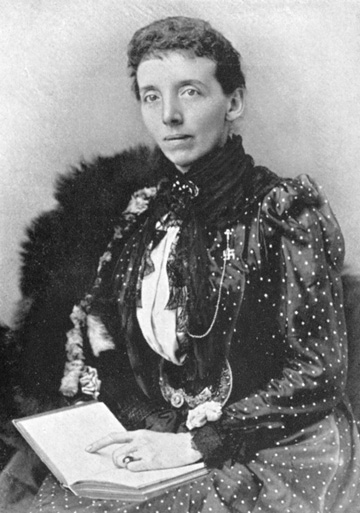<Back to Index>
- Theosophist Isabel Cooper - Oakley, 1853
- Theosophist Wlliam Scott - Elliot, 1850+
PAGE SPONSOR

Harriet Isabella (Isabel) Cooper-Oakley (31 January 1854 – 3 March 1914), was a prominent Theosophist and author.
She was born in Amritsar, India to (Frederic) Henry Cooper, C.B., commissioner of Lahore and his wife Mary (née Steel), receiving a good education because of her father's belief in the value of education for women. She had suffered a severe injury in an accident aged 23 which prevented her from walking for two years, during which time she intensified her reading. She went on to study at Girton College, Cambridge, and whilst at the university, she met - and later married - fellow student Alfred John Oakley. They then both changed their surname to Cooper - Oakley. Alfred stayed some years at Adyar, India, as an assistant to Henry Steel Olcott. He left to become Registrar of the University of Madras.Sometime in the late 1890s, G.R.S. Mead became her brother - in - law when he married her sister, another prominent Theosophist, Laura Cooper.
Isabel Cooper - Oakley died on March 3, 1914, at Budapest, Hungary.

William Scott - Elliot (1849 - 1919) was a theosophist who elaborated Helena Blavatsky's concept of root races in several publications, most notably The Story of Atlantis (1896) and The Lost Lemuria (1904), later combined in 1925 into a single volume called The Story of Atlantis and the Lost Lemuria.
Scott - Elliot was an investment banker and amateur anthropologist. An early member of the London Lodge of the Theosophical society, in 1893 he wrote The Evolution of Humanity, issued as part of the Transactions of the London Lodge (issue 17).
Scott - Elliot came into contact with theosophist Charles Webster Leadbeater who said he received knowledge about ancient Atlantis and Lemuria from the Theosophical Masters by "astral clairvoyance." Leadbeater transmitted his clairvoyant findings to Scott - Elliot, who undertook scholarly research to back them up. Despite Leadbeater's contributions, Scott - Elliot was listed as the sole author of the resulting book The Story of Atlantis, which was published with a preface by Alfred Percy Sinnett.
In 1899 he was awarded the T. Subba Row Medal for his contributions to "esoteric science and philosophy". In 1904 he added detail on Lemuria in The Lost Lemuria, attempting to use contemporary scientific evidence to back up Leadbeater's claims.
Leadbeater and Scott - Elliot provided much more detail than Blavatsky on the lives of the supposed Atlantean and Lemurian root races. Scott - Elliot located Lemuria in the Pacific ocean, claiming that it was a gigantic landmass that eventually sank, leaving only small islands. The Lemurians were around fifteen feet tall, with brown skins and flat faces, no foreheads and prominent jaws. They could see sideways like birds, and could walk backwards and forwards with equal ease. They reproduced with eggs, but interbred with animals to produce ape - like human ancestors.
After the demise of Lemuria, new races emerged on Atlantis from the surviving ape - like creatures. This led to the Atlantean races, beginning with the black skinned "Rmoahal" and leading to the "copper colored" Tlavatli, who were ancestor - worshippers, and then the "Toltecs", who had advanced technology including "airships". The Toltecs were succeeded by "First Turanians" and then "Original Semites". These later produced further sub-races, the Akkadians and Mongolians. A group of Akkadians migrated to Britain 100,000 years ago, where they built Stonehenge. The crudity of the design in contrast to Atlantean architecture is explained by the fact that "the rude simplicity of Stonehenge was intended as a protest against the extravagant ornament and over decoration of the existing temples in Atlantis, where the debased worship of their own images was being carried on by the inhabitants."
Scott - Elliot also claimed that Atlantis split into two linked islands, one called Daitya, and the other Ruta. Eventually only a remnant of Ruta remained, called Poseidonis, before that too disappeared.
Scott - Elliot's ideas were later co-opted by Rudolf Steiner in Atlantis and Lemuria (1913).